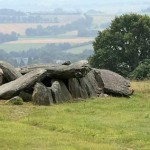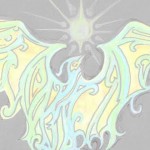The sun is invisible in people, but visible in the world; yet both are of one and the same sun.
Gerhard Dorn, Theatrum Chemicum Volume 1, Speculativa Philosophia
Each of us has a unique path to Paganism. Some of us find that it is when we are in nature that we most sense the sacred and holy – we feel nearer the Divine beneath sky than buildings. For some, it is the Divine Feminine, the Goddess, that calls us. Others are drawn to a particular ancient deity or pantheon. It may be that we experience the Divine mind of the universe as an abstract energy rather than a personal deity. We may be seeking not to worship a deity, but to attain a state of consciousness in which we feel united to and in communion with nature, the wider universe, and all humankind.

The Sacred Quest
Our Pagan path may or may not include formal rites of initiation, but many of us share a sense that we are on an initiatory journey, a sacred quest. That journey may begin for reasons that are deeply personal. We may be seeking healing, comfort, love, powers, knowledge, or meaning. We may not even know why or what we are seeking; only that we have a deep sense that human beings have a purpose and that there is more to life than material reward and success.
Above some of the temples of the ancient mystery traditions were the words, ‘Know Thyself.’ The implication is that if we want to grow closer to the Gods, we must know who and what we are. But this is not fixed, it is continually evolving. As we practice our Paganism, as we meet others who share our values and have compatible visions, as we begin to work perhaps with others in ritual, in environmental work, or in community events, the journey begins to change us. We begin to understand our strengths and limitations. And if we work with others, we begin to see what our contribution can be to the great endeavor that we have embarked upon together. This endeavor is sometimes called ‘The Great Work’. People have many different ways of interpreting what this expression means, but one is that the Great Work is about the transformation of humankind. That work must start with what is closest to us – ourselves.
Symbols not words
Contemporary Paganism is not a ‘religion of the book’. Symbolic objects are more important than written words. Much of the teaching is conveyed subtly, through ritual and symbolic actions. These ancient pre-verbal modes of communication speak to the right brain rather than to the left. By engaging the body and participating physically in our rites, we open the inner eye to see. We allow images and symbols to speak to our unconscious so that they awaken us to insights and meanings that can guide us on our path.
Midsummer Marriage
Some of the ritual actions of our traditions become so familiar that we may barely notice them, but our repeated exposure to them is a kind of enculturation that over time begins to form our worldview. For many of us, the Chalice or Cup is nearly always there; so much so that we can cease to notice the symbolic gesture we repeat each rite – the uniting of cup with blade or wand.
This gesture is central to Midsummer, when many of us celebrate the marriage of Fire and Water, the unification of the Spear of Lugh and the Cauldron, the watery womb of the Goddess. Cauldron, Cup, Grail, and alchemical vessel – all these sacred vessels have similar properties. They transform what they contain into something that is more than the sum of the parts. The sacred marriage gives birth to alchemical gold, the sun child of promise, the golden elixir of gives healing and immortality, and the inner sun of the True Self.
Indiana Jones and the Last Crusade
From the True Self to Steven Spielberg may seem a big leap, but his movie Indiana Jones and the Last Crusade takes up the idea of Grail Quest and some of the true story of the obsession of Nazi Grail hunters to find the sacred relic. Sean Connery plays the role of Professor Henry Jones, a Grail expert, who is kidnapped by Nazis to force him to reveal the whereabouts of the Grail. His son, the adventurer Indiana Jones (Harrison Ford) tries to rescue him, but Professor Jones is shot. To save him, Indiana Jones must obtain the Grail from the cave where it has been hidden and guarded for centuries and pour water from the Grail onto his father’s wound. The Grail heals the Professor, but the Nazi Dr. Else Schneider is destroyed when she tries to take the Grail for herself and the Grail passes out of manifestation into the Otherworld. Now the true purpose of the journey is revealed. It is not possession of a powerful magickal object; for as we know, if we do not find what we seek within us, we can never find it without us. The purpose of the quest is to be changed by the journey.
Professor Henry Jones: Elsa never really believed in the grail. She thought she’d found a prize.
Indiana Jones: And what did you find, Dad?
Professor Henry Jones: Me? Illumination.
Becoming the Grail
The Grail quest is a journey within, to the True Self, the hidden centre of our being; but that is not the end of the story. The sacred marriage of Cauldron and Spear at Midsummer also marries the king to the land, symbolizing willingness to serve others and the wider world. Midsummer is a time to affirm our dedication to spiritual quest, not to attain something but to become something. The secret is not to find the Grail, but to become the Grail – a source of love, compassion and spiritual vision, from which others may drink.
I am a well in the desert,
I contain both light and water,
they may draw from me what they will.
The light of Sun and Moon replenish me,
I am the Grail.
Commencing Sunday October 7 2014, Vivianne Crowley will be running a four-week online Insights course for Cherry Hill Seminary on ‘The Grail and the Spiritual Quest’. Information can be found here.
Read this article in French, Italian, Polish, Russian, or Spanish!
















